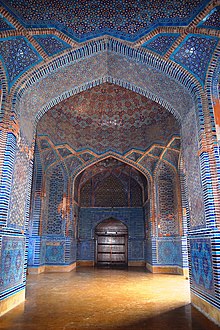
Back مسجد شاه جهان (السند) Arabic مسجد شاه جهان ARZ শাহজাহান মসজিদ Bengali/Bangla Shah-Jahan-Moschee (Thatta) German Mezquita de Shah Jahan Spanish مسجد شاهجهان (تهته) Persian Moschea Shah Jahan (Thatta) Italian 샤 자한 모스크 Korean ഷാജഹാൻ മോസ്ക്, തട്ട Malayalam Masjid Shah Jahan, Thatta Malay
| Shah Jahan Mosque | |
|---|---|
شاہ جہاں مسجد | |
 | |
| Religion | |
| Affiliation | Islam |
| District | Thatta |
| Province | Sindh |
| Year consecrated | 1647 |
| Location | |
| Location | Thatta Pakistan |
| Architecture | |
| Style | Safavid, Timurid, Mughal |
| Completed | 1659 |
| Specifications | |
| Dome(s) | 93 |
| Materials | Red bricks and tiles |
The Shah Jahan Mosque (Urdu: شاہ جہاں مسجد, Sindhi: مسجد شاهجهاني،, Persian: مسجد شاهجهان), also known as the Jamia Masjid of Thatta (Urdu: جامع مسجد ٹھٹہ, Sindhi: شاھجھاني مسجد ٺٽو), is a 17th-century building that serves as the central mosque for the city of Thatta, in the Pakistani province of Sindh. The mosque is considered to have the most elaborate display of tile work in South Asia,[1][2] and is also notable for its geometric brick work - a decorative element that is unusual for Mughal-period mosques.[3] It was built during the reign of Mughal emperor Shah Jahan, who bestowed it to the city as a token of gratitude,[1] and is heavily influenced by Central Asian architecture - a reflection of Shah Jahan's campaigns near Samarkand shortly before the mosque was designed.[1]
© MMXXIII Rich X Search. We shall prevail. All rights reserved. Rich X Search